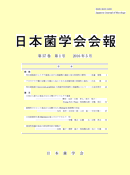Volume 35, Issue 3
Displaying 1-9 of 9 articles from this issue
- |<
- <
- 1
- >
- >|
Full Paper
-
1994Volume 35Issue 3 Article ID: jjom.H05-173
Published: 1994
Released on J-STAGE: March 31, 2023
Download PDF (552K) -
1994Volume 35Issue 3 Article ID: jjom.H05-181
Published: 1994
Released on J-STAGE: March 31, 2023
Download PDF (914K)
Short communications
-
1994Volume 35Issue 3 Article ID: jjom.H05-189
Published: 1994
Released on J-STAGE: March 31, 2023
Download PDF (482K) -
1994Volume 35Issue 3 Article ID: jjom.H05-192
Published: 1994
Released on J-STAGE: March 31, 2023
Download PDF (756K)
-
1994Volume 35Issue 3 Pages 200-202
Published: 1994
Released on J-STAGE: March 06, 2024
Download PDF (265K) -
1994Volume 35Issue 3 Pages 203-207
Published: 1994
Released on J-STAGE: March 06, 2024
Download PDF (367K) -
1994Volume 35Issue 3 Pages 208-210
Published: 1994
Released on J-STAGE: March 06, 2024
Download PDF (1039K) -
1994Volume 35Issue 3 Pages 211-213
Published: 1994
Released on J-STAGE: March 06, 2024
Download PDF (233K) -
1994Volume 35Issue 3 Pages 214-216
Published: 1994
Released on J-STAGE: March 06, 2024
Download PDF (1550K)
- |<
- <
- 1
- >
- >|
